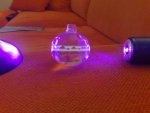All glasses have amorphous structure, and varying degrees of crystallization from their ingredients and/or their processing. Very few glasses are pure silica, because that would make it very hard to process (this can be done, it's called fused quartz: it's still a glass (whereas quartz is crystalline silica), but it's much higher quality because it's much more pure). The names for all these things are terrible because of history and such, but basically everything out there that is glass is silica with other stuff added to it (unless it's fused quartz, but you'd know if it was). And it's all amorphous, but with slightly varying degrees of crystallinity: The order will only extend slightly beyond nearest-neighbors.
To make glass melt easier for processing or to make it better for certain properties, other things are added, like boron for borosilicate glass (aka Pyrex), or soda and lime, for soda-lime-silicate glass, the most common glass out there (like most drinking glasses and windows). "Crystal", that really expensive glassware everyone loves, it's actually just glass with extra lead added to it: It's still glass, but the lead increases the index of refraction, and makes it shinier (so the name "crystal" is the worst name ever, continuing the misleading name trend).
Many of the things added to glass to make its properties better can fluoresce, like the boron or other things. They add all kinds of stuff to glass to get it to flow right or to "solidify" right. Glass is crazy stuff with how it works and has to be processed. Metallic glasses are just as interesting, but with some amazing properties that are only just starting to come out. There's still SO much to learn about how amorphous solids behave, we're just beginning to understand them. It also hurts that cause that there are still so many misconceptions about glass out there (ie, I bet some people on this thread still believe that glass "flows", and that this results in the windows in old buildings "flowing" and getting thicker at the bottom than at the top. Hopefully no one here still believes that.)






